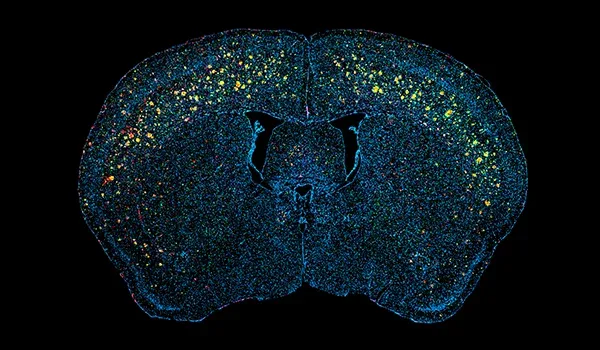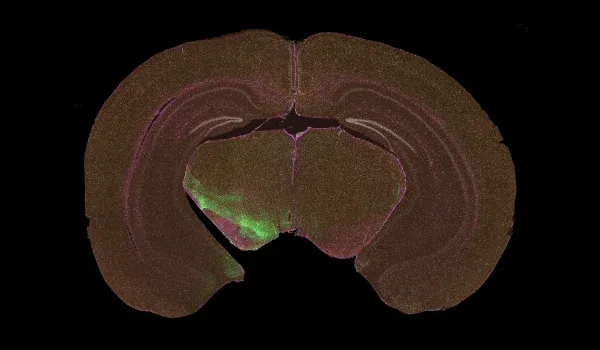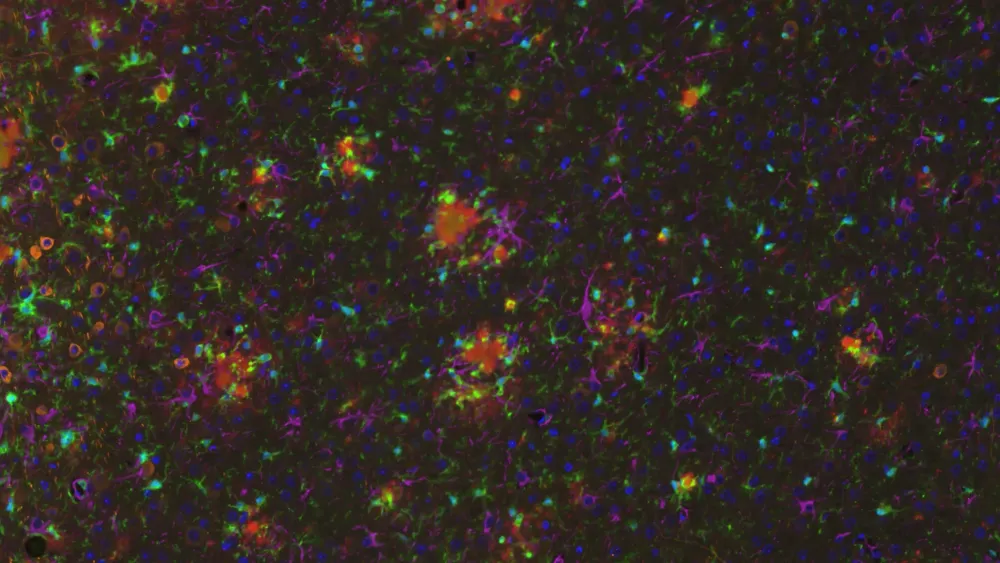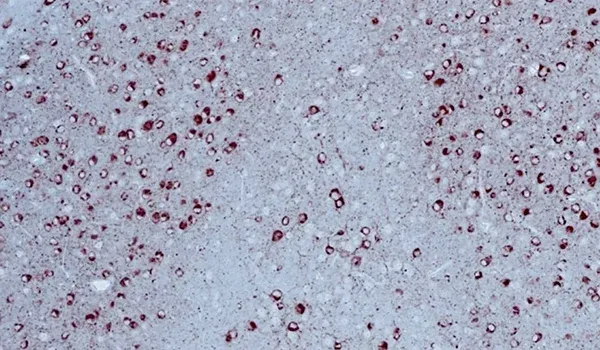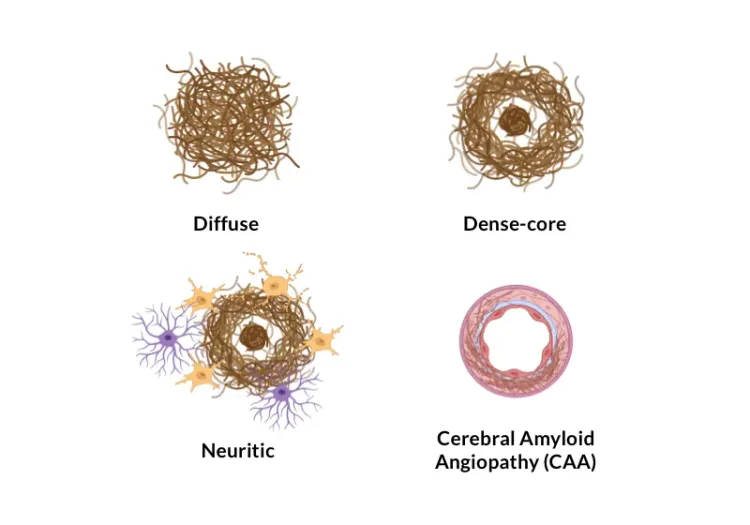Tau, Rather than Amyloid-β, Drives Neurodegeneration in Alzheimer's Disease (AD) and Mouse Models of AD
Amyloid-β Transgenic Models
The beta-amyloid pathology that is a hallmark of human Alzheimer's disease can be modelled via overexpression of mutant human amyloid precursor protein (APP) and presenilin 1 (PS1; PSEN1) in transgenic mice. Similar to human disease, the evolution of the pathology increases with age.
The APP/PS1 model that we use for preclinical evaluation of the efficacy of experimental, disease-modifying therapeutic agents is highly reproducible and replicates several key features of human AD. These mice show progressive development amyloid-beta (Aβ) plaques, cerebrovascular pathology, and neuroinflammation. The response to therapeutic intervention can be assessed by several quantitative readouts, including advanced image analysis of multiplex immunofluorescence staining of digitized brain tissue sections.
AAV Tau Mouse Models of Tauopathies
Generation of tau pathology in the adult rodent brain can be generated via injection of adeno-associated virus (AAV) vectors. In this mouse model of tauopathy (Progressive Supranuclear Palsy, Corticobasal Degeneration), wild-type (C57BL/6) mice undergo stereotaxic injection of AAV vectors overexpressing wild-type human tau into the vicinity of the substantia nigra pars compacta.
This robust tauopathy model pathologically shows phosphorylated tau aggregates in the neuron soma and neurites, neuroinflammation (including activated microglia and reactive astrocytes), neurodegeneration (including regional brain atrophy on in vivo MRI scans), and dopaminergic denervation. Significant motor deficits are observed in these tauopathy mice models resulting from the unilateral dopaminergic neuron loss, including alterations in the cylinder test, tail suspension swing test, hindlimb clasping test, and rotarod test.
Amyloid-Beta & Tau Co-Pathology Model
Our amyloid-beta (Aβ) and tau co-pathology mouse model captures two defining features of Alzheimer’s disease — Aβ plaque accumulation and tau-associated neurodegeneration — by combining transgenic and viral vector-based methodologies. This model offers a robust and translationally relevant platform for investigating disease mechanisms & assessing the efficacy of disease-modifying therapeutic interventions for Alzheimer's disease.
The amyloid-β pathology is established using APP/PS1 transgenic mice, which exhibit age-dependent Aβ plaque deposition. To induce tauopathy, adeno-associated virus (AAV) vectors encoding wild-type human tau (2N4R) are delivered via stereotaxic injection into disease-relevant brain regions. This targeted expression leads to the accumulation of phosphorylated tau aggregates within neuronal soma and processes. This co-pathology model demonstrates marked neuroinflammation, neurodegeneration, and associated functional impairments, reflecting complex pathological interactions relevant to Alzheimer's disease.
Tau Fibril Spreading Models
Generation of tau pathology in the adult mouse brain can be generated via inoculation of recombinant tau fibrils or human brain extracts. In this mouse model of Alzheimer's disease, P301S mutant tau (PS19) transgenic mice undergo stereotaxic injection of tau preformed fibrils (PFFs) into the brain to induce seeding & spreading of tau pathology.
This robust tau mouse model shows hyperphosphorylated tau aggregates in the cell bodies and processes of neurons, neuroinflammation (including activated microglia and reactive astrocytes), and neurodegeneration. Therapeutic efficacy can be evaluated using clinical assessments (e.g. change in body weight), measurement of neurofilament light chain in blood & CSF, and quantitative immunohistochemistry & multiplex immunofluorescence analysis.
Translatability of our Alzheimer's Disease & Tauopathies Models to Human Disease
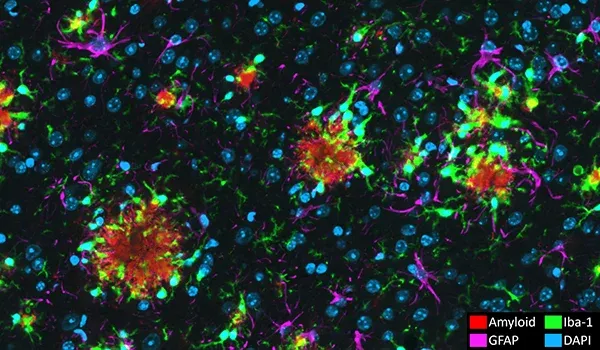
Amyloid-β Plaques & Cerebrovascular Pathology
Extracellular plaques and cerebrovascular deposits of aggregated amyloid-β are neuropathologic hallmarks of Alzheimer's disease (Serrano-Pozo, 2011). Our APP/PS1 mouse model show time-dependent increases in amyloid-β pathology (including diffuse, dense-core, and neuritic plaques, intracellular amyloid-β, and cerebrovascular pathology). The Aβ pathology progresses in a well-defined spatiotemporal pattern and can be quantified using sophisticated algorithms developed by our team.
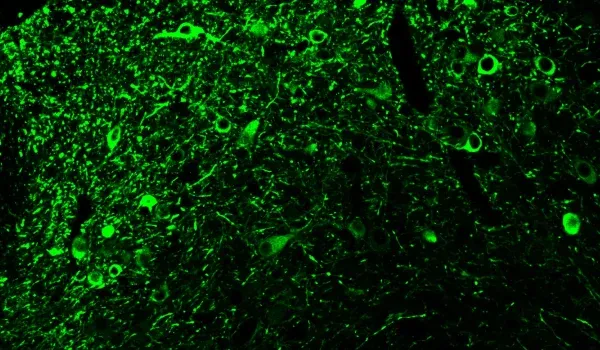
Tau Pathology
In addition amyloid-β, tau is a key misfolded protein found in Alzheimer's disease. Tau is thought to be the primary driver of some of the clinical and neuroimaging features of AD (Lew, 2021; Carbonell, 2025). Our APP/PS1/human Tau model demonstrates both amyloid-β and tau pathology. Phosphorylated tau staining is observed in cell bodies and processes. Tauopathies, such as Progressive Supranuclear Palsy, Corticobasal Degeneration, and Frontotemporal Dementia, show pure tau pathology in specific brain regions. In our AAV-hTau model, we are able to target tau expression to the substantia nigra and midbrain regions to effectively model tauopathies with Parkinsonian features.
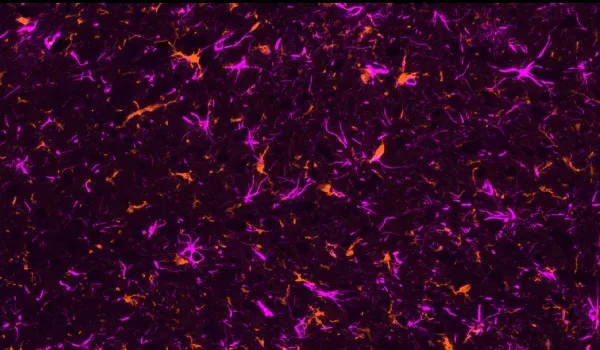
Activated Microglia & Reactive Astrocytes
Neuroinflammatory cells, including activated microglia and reactive astrocytes, are found in close proximity to misfolded amyloid-β and tau (Minter, 2015; Chen and Yu, 2023). In our APP/PS1 mouse model, we have demonstrated a spatial and temporal relationship between Aβ plaques, activated microglia, and non-activated microglia, as well as between Aβ plaques and hypertrophic & non-hypertrophic astrocytes. We also observe a strong microgliosis and astrogliosis in relation to phosphorylated tau in our APP/PS1/hTau co-pathology and our AAV-induced tauopathy models.
Tauopathy Driven Parkinsonian Motor Features
Progressive Supranuclear Palsy and Corticobasal Degeneration are pure tauopathies which, amongst other clinical manifestations, are characterized by Parkinsonian features and severe loss of neurons in the substantia nigra (Oyangi, 2001). In our AAV-hTau model, we have found significant motor deficits (based on the Cylinder Test, Tail Suspension Swing Test, Rotarod Test, and Hindlimb Clasping Test) as a result of degeneration of dopaminergic neurons in the substantia nigra and corresponding denervation of the striatum.
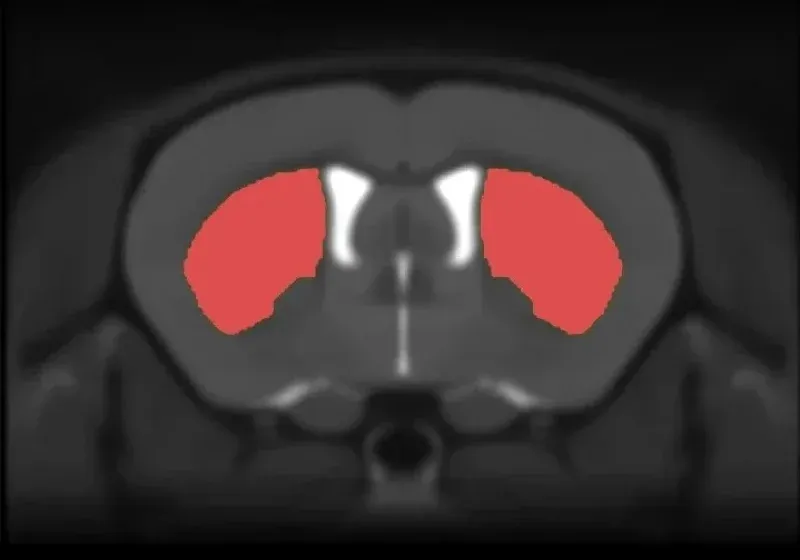
Regional Brain Atrophy
Multi-modality imaging biomarkers are widely used in clinical trials of Alzheimer's disease and tauopathies. MRI-derived regional volume and cortical thickness measures are highly sensitive to brain atrophy and allow for monitoring disease progression over time in Alzheimer's disease, Progressive Supranuclear Palsy, Corticobasal Degeneration, and Frontotemporal Dementia. Using non-invasive, in vivo whole brain MRI acquisition combined with advanced, fully-automated image processing & analysis, we have shown highly significant regional brain atrophy, specifically related to tau pathology, thereby serving as a robust in-life measure of neurodegeneration and a translational biomarker.
Alzheimer's Disease Mouse Models & Neurodegeneration
The Interactive Presentation below allows you to explore the relationship between amyloid-β, tau, and brain atrophy in human AD and our Alzheimer's disease mouse models, including in vivo data and high-resolution images of entire Multiplex Immunofluorescence tissue sections.
You can simply navigate through this "Image Story" using the left panel.
You can pan around the high-resolution microscopy images using the left mouse button. You can zoom in and out using the mouse/trackpad (up/down) or the + and - buttons in the upper left corner. You can toggle (on/off), change color, and adjust image settings for the channels and segmentations in the Control Panel in the upper right corner.
We suggest using Full Screen Mode for the best interactive experience.
Learn more about our characterization of these Alzheimer's Disease & Tauopathies mouse models, our validated measures, and our Preclinical Neuroscience CRO services.
Related Content
Up-to-date information on Alzheimer's disease and best practices related to the evaluation of therapeutic agents in Alzheimer's disease animal models.
Amyloid-β & Inflammatory Microenvironment in Alzheimer's Mice
We have analyzed the complex spatial relationships between β-amyloid plaques, activated & resting microglia, and astrocytes in an APP/PS1 transgenic model.
Microglia Morphology in ALS, Alzheimer's Disease & Parkinson's Disease
An overview of microglial morphological analysis and the applications to neurodegenerative disease research and drug discovery & development.
Amyloid-β Plaque Analysis in Alzheimer's Disease
Overview of methods to classify & quantify Aβ plaques in brain tissue sections from humans & Alzheimer’s disease animal models (transgenic mice & rats).
